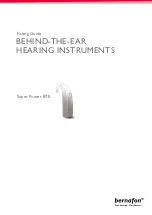
Real-Ear Measurements
145
6.4.2 Measuring in the Real-ear SPL screen
In the past ten years, the SPL method of performing real-ear measurement has
increased in popularity. In the SPL method, the patient’s hearing threshold lev-
els (HTLs), uncomfortable levels (UCLs), real-ear target, and real-ear measure-
ments are displayed together on one graph in terms of dB SPL. This allows for a
direct comparison of audiometric measurements and real-ear measurements.
The goal in the SPL method is to ensure the response of the hearing aid to soft
signals (50 dB SPL) reach above the patient’s HTLs, the response to average
signals (65-80 dB SPL) meet the target, and the response to loud signals (90 dB
SPL) are below the UCLs.
In the Real-ear SPL screen (Figure 6.4.2), the patient’s HTLs and UCLs are dis-
played on one large graph together with up to three real-ear targets and five real-
ear measurements. The three targets (L, M, and H) are matched to the source
type and amplitude of REAR 2, REAR 3, and REAR 4, respectively. That is,
Target Curve L is appropriate for the settings used in REAR 2, M is appropriate
for REAR 3, and H is appropriate for REAR 4. When changing the source type or
amplitude of any of these three measurement curves, the target will automati-
cally adjust. These curves are color coded to make it easier to match the mea-
surement curve to the appropriate target. Target L and REAR 2 are blue, Target
M and REAR 3 are green, and Target H and REAR 4 are red.
The long term average speech spectrum (LTASS) is also displayed as three
dotted “l”, “m”, and “h” curves. The LTASS is the average real-ear unaided
response. The “m” curve is the real-ear unaided response at 70 dB SPL. The “h”
curve is 12 dB above this curve, and the “l” curve is 18 dB below it. The three
curves of the LTASS are used as a comparison tool to the aided measurement
curves to demonstrate the amplication advantage provided by the hearing aid.
During a typical real-ear measurement using the SPL method:
1. The probe tube AND hearing aid are inserted into the ear canal. (Section
6.2.3)
2. The sound field speaker is leveled. (Section 6.2.4)
3. The hearing aid is carefully inserted into the ear.
4. The aided response is measured (Section 6.4.4) with an input signal of 50
dB SPL and compared to the patient’s HTLs.
5. The aided response is measured with an input signal of 65 dB SPL and com-
pared to the real-ear target.
6. The aided response is measured with an input signal of 90 dB SPL and com-
pared to the patient’s UCLs
Most of the operations of the Real-ear SPL screen are identical to the opera-
tions of the Insertion Gain screen. Therefore, most of the instructions found in
Содержание FONIX 7000
Страница 2: ......
Страница 8: ......
Страница 189: ...Calibration 181 Figre B 2 Calibrating the insert earphone ...
Страница 190: ...182 FONIX 7000 Hearing Aid Analyzer ...
Страница 200: ...192 FONIX 7000 Hearing Aid Analyzer ...
Страница 204: ...196 FONIX 7000 Hearing Aid Analyzer ...














































